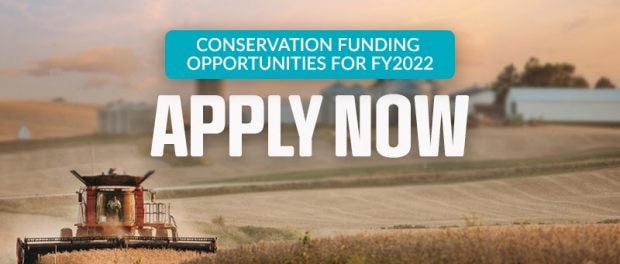Conservation Funding Opportunities for 2022

NRCS Announces Conservation Funding Opportunities for 2022
The U.S. Department of Agriculture (USDA) is announcing fiscal year 2022 assistance opportunities for agricultural producers and private landowners for key programs, such as the Environmental Quality Incentives Program (EQIP), Conservation Stewardship Program (CSP), Agricultural Conservation Easement Program (ACEP), and Agricultural Management Assistance (AMA) program. While USDA’s Natural Resources Conservation Service (NRCS) accepts applications for these programs year-round, producers and landowners should apply by state-specific, ranking dates to be considered for this year’s funding.
Through conservation programs, NRCS provides technical and financial assistance to help producers and landowners make conservation improvements on their land that benefit natural resources, build resiliency and contribute to the nation’s broader effort to combat the impacts of climate change.
“NRCS conservation programs are good for natural resources and for your operation’s bottom line,” said NRCS Chief Terry Cosby. “Whether this is your first time working with NRCS or you want to take conservation to the next level on your land, we encourage you to contact your local NRCS field office to learn more.”
Applying for Conservation Funding Assistance
NRCS accepts applications for its conservation programs year-round. State Technical Committees, composed of conservation and agricultural-related agency and organization representatives, work with NRCS to identify resource priorities and how best to address them. NRCS then sets state-specific, ranking dates to evaluate applications for funding that account for producer needs, staff workload and ensure potential participants have ample opportunities to apply. You should apply by your state’s ranking dates to be considered for funding in the current cycle. Funding is provided through a competitive process.
State-specific, ranking dates for all programs are available. Applications received after ranking dates will be automatically deferred to the next funding period.
Producers, landowners and forest managers interested in applying for assistance should contact the NRCS at their local USDA Service Center  .
.
Program Options
EQIP provides cost share assistance for producers to use 170-plus conservation practices to address a wide variety of resource concerns. Within EQIP, Conservation Incentive Contracts allow producers to further target priority resource concerns. CSP helps producers take their conservation activities to the next level through comprehensive conservation and advanced conservation activities. ACEP helps producers enroll wetlands, grasslands and farmlands into easements for long-term protection. Additionally, through RCPP, producers and landowners can work with partners who are co-investing with NRCS on targeted projects.
Historically Underserved Producer Benefits
Special provisions are also available for historically underserved producers. For EQIP, historically underserved producers are eligible for advance payments to help offset costs related to purchasing materials or contracting services up front. In addition, historically underserved producers can receive higher EQIP payment rates (up to 90% of average cost). NRCS sets aside EQIP, CSP and ACEP funds for historically underserved producers.
NRCS also recently announced the availability of funding for cooperative agreements for partners to provide outreach and support for historically underserved producers. Applications from individuals and entities are due Oct. 25.
Conservation Practices and Climate
NRCS conservation programs play a critical role in USDA’s commitment to partnering with farmers, ranchers, forest landowners and local communities to deliver climate solutions that strengthen agricultural operations and rural America. States may prioritize a variety of voluntary conservation practices through these NRCS programs, including those that support climate-smart agriculture and forestry (CSAF).
In fiscal year 2022, EQIP and CSP will provide targeted funding for CSAF practices, and Conservation Incentive Contracts – a new EQIP program – will be available nationwide with an emphasis on CSAF practices. Building on these efforts, NRCS will also prioritize climate investments through ACEP, RCPP and Conservation Innovation Grants.
Under the Biden-Harris Administration, USDA is engaged in a whole-of-government effort to combat the climate crisis and conserve and protect our nation’s lands, biodiversity and natural resources including our soil, air and water. Through conservation practices and partnerships, USDA aims to enhance economic growth and create new streams of income for farmers, ranchers, producers and private foresters. Successfully meeting these challenges will require USDA and our agencies to pursue a coordinated approach alongside USDA stakeholders, including State, local and Tribal governments.
USDA touches the lives of all Americans each day in so many positive ways. In the Biden-Harris Administration, USDA is transforming America’s food system with a greater focus on more resilient local and regional food production, fairer markets for all producers, ensuring access to healthy and nutritious food in all communities, building new markets and streams of income for farmers and producers using climate smart food and forestry practices, making historic investments in infrastructure and clean energy capabilities in rural America, and committing to equity across the Department by removing systemic barriers and building a workforce more representative of America. To learn more, visit www.usda.gov.








 Your Privacy Choices
Your Privacy Choices
Leave a comment